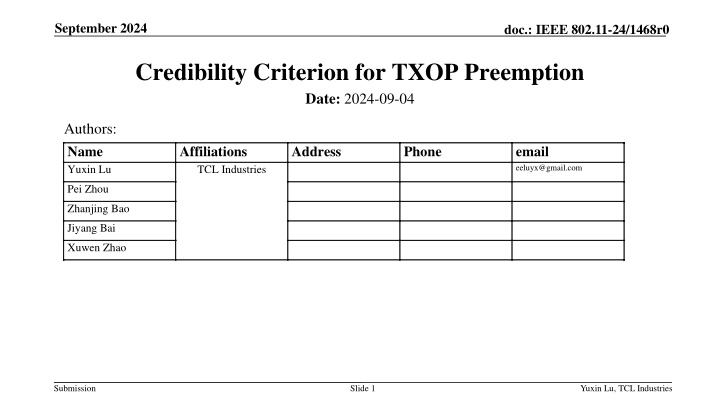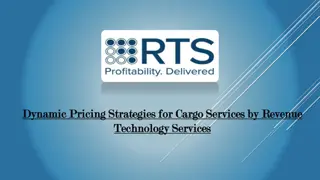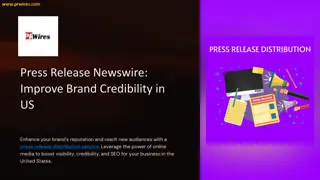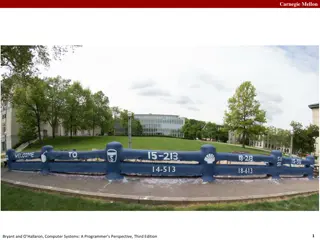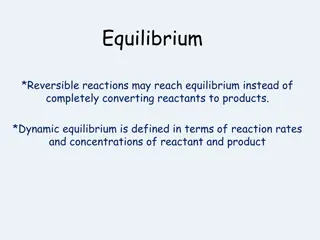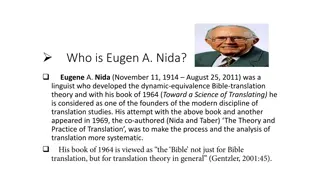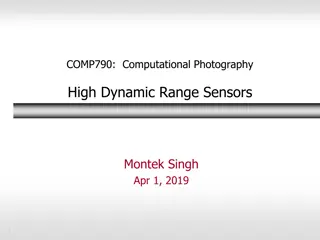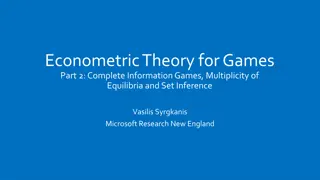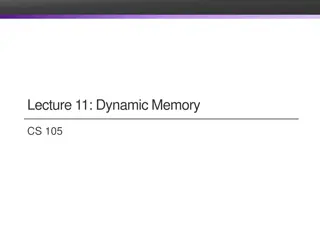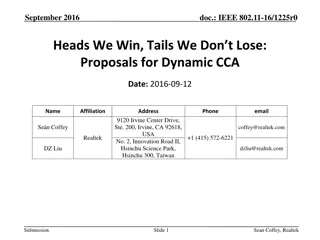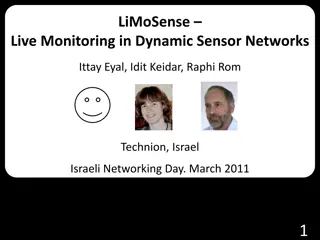Crafting a Dynamic Presentation
Unleash the power of visual storytelling with tips on using templates effectively, customizing layouts, and creating an engaging PowerPoint narrative. Explore a guide for Mac and PC users, experiment with fonts and colors, and master the art of slide design. Discover how to add text, images, and sections seamlessly while keeping your audience captivated with striking backgrounds and impactful quotes. Elevate your presentation skills and leave a lasting impression with a visually appealing and informative slideshow.
Download Presentation

Please find below an Image/Link to download the presentation.
The content on the website is provided AS IS for your information and personal use only. It may not be sold, licensed, or shared on other websites without obtaining consent from the author.If you encounter any issues during the download, it is possible that the publisher has removed the file from their server.
You are allowed to download the files provided on this website for personal or commercial use, subject to the condition that they are used lawfully. All files are the property of their respective owners.
The content on the website is provided AS IS for your information and personal use only. It may not be sold, licensed, or shared on other websites without obtaining consent from the author.
E N D
Presentation Transcript
September 2024 doc.: IEEE 802.11-24/1468r0 Credibility Criterion for TXOP Preemption Date: 2024-09-04 Authors: Name Yuxin Lu Affiliations TCL Industries Address Phone email eeluyx@gmail.com Pei Zhou Zhanjing Bao Jiyang Bai Xuwen Zhao Submission Slide 1 Yuxin Lu, TCL Industries
September 2024 doc.: IEEE 802.11-24/1468r0 Introduction Latency reduction is one key objective as stated in UHR proposed PAR [1] Several contributions [2]-[19] have made progress to support low latency medium access by constructing and furnishing the preemption mechanism Among various branches, TXOP level preemption is a necessary branch towards achieving latency reduction In this proposal, we focus on the TXOP level preemption, introducing a credibility criterion to assist the fair classification among streams and honest behavior between STAs to further promote the preemption feature Submission Slide 2 Yuxin Lu, TCL Industries
September 2024 doc.: IEEE 802.11-24/1468r0 Re-cap [19]: Preemptor VS Preemptee Focusing on in BSS preemption Preemptor: A STA who acquires the preempted transmission duration by initiating preemption The STA can be either AP or non-AP For traffic of AC2 that takes precedence over the current traffic of AC1, such as higher-priority traffic over lower-priority traffic Preemptee: A non-AP STA who grants or accepts preemption by suspending the current traffic transmission or reception of AC1 In the top view of traffic delivery, AP helps STAs forward traffic (either DL or UL), but does not generate traffic, only traffic intended for non-AP STA can be preempted The non-AP STA is either TXOP holder or TXOP responder Exceptional scenario: Preempt DL/UL TXOP to transmit UL/DL higher-priority traffic Preemptor: EDCAF(AC2) Preemptee: EDCAF(AC1) Submission Slide 3 Yuxin Lu, TCL Industries
September 2024 doc.: IEEE 802.11-24/1468r0 Problem Statement What is low latency stream [16] Static LL stream definition: any traffic in AC_VO ? or may be some with newUP/TID/AC? Dynamic LL definition: buffered frames of a stream for which certain delivery delay timer is expiring? How to achieve approximate fairness between streams? Considering static LL definition, which potentially may cause preemption request bloating problem in highly loaded network scenario Considering dynamic LL definition, which potentially may let any stream to be classified as latency sensitive or delay sensitive stream Besides, how to avoid possible misapplication among STAs? Considering the preemptor STAs may aggressively or frequently preempt other STA s legal TXOP for its own benefits, which would cause bad user experience for the preemptee STA Submission Slide 4 Yuxin Lu, TCL Industries
September 2024 doc.: IEEE 802.11-24/1468r0 General Solution Propose to introduce a credibility criterion to assist the fair classification among streams and honest behavior between STAs Each STA supporting preemption has a credibility parameter that reflects the quality/capability of its preemption behavior, in terms of how much of other STAs TXOP it has borrowed (by being preemptor) and how much it has managed to be returned (by being preemptee and lend TXOP to other STAs) credibility is a local parameter calculated at the potential preemptee side With the help of credibility parameter, the potential preemptee chooses whether to grant preemption Potential effect: In order to establish positive credibility, STAs that borrowed/preempted TXOP would return it in another preemption occurrence, formulating virtuous circle Benefit 1: Achieve approximate fairness between streams Considering static LL, limit the preemption request bloating, especially in highly loaded network scenario Considering dynamic LL, implicitly restrict LL classification at each STA s (potential preemptor s) local side Benefit 2: Avoid possible misapplication among STAs Limit the situation where preemptor STAs aggressively or frequently preempt other STA s legal TXOP for its own benefits, further limit bad user experience for the preemptee STA Submission Slide 5 Yuxin Lu, TCL Industries
September 2024 doc.: IEEE 802.11-24/1468r0 Preemption Response Decision Making Potential preemptee sends preemption response, accept or reject preemption request Given a credibility threshold If preemptor s credibility is below such credibility threshold , then the potential preemptee may choose to reject its preemption request In case multiple preemptors initiate preemption request, the potential preemptee can determine how to respond according to their relative credibility Preemption response decision may be made by considering credibility criterion together with the essential parameters in preemption request, such as AC or TID: To indicate (static) LL stream classification Delay information To indicate (dynamic) LL stream classification Request preemption start time Scheduled preemption Request preemption duration Airtime to be preempted/shared Submission Slide 6 Yuxin Lu, TCL Industries
September 2024 doc.: IEEE 802.11-24/1468r0 Credibility Criterion Calculation Method Preemption duration can provide information regarding STA s credibility Credibility calculation during a given time window, sliding window or discrete window Method 1: Credibility of STA1 (at STA2) reflects the total returned duration minus the total borrowed duration to/from STA2 Method 2: Credibility of STA1 (at STA2) reflects the total returned duration divided by the total borrowed duration to/from STA2 At first time of preemption occurrence, such information may not be sufficient in reflecting credibility For a new joiner, additional design is needed (see follow-up discussion) Example Credibility of STA1 (Method 1) Credibility of STA2 (Method 1) Credibility of STA1 (Method 2) Credibility of STA2 (Method 2) Preemption Occurrence Preemption Duration Preemptor Preemptee First time STA1 STA2 t1 -t1 t1 0 inf Second time STA1 STA2 t2 -t1-t2 t1+t2 0 inf Third time STA2 STA1 t3 -t1-t2+t3 t1+t2-t3 t3/(t1+t2) (t1+t2)/t3 Submission Slide 7 Yuxin Lu, TCL Industries
September 2024 doc.: IEEE 802.11-24/1468r0 Include Rejection Reason in Preemption Response By including rejection reason in preemption response, can Motivate preemptor to improve its credibility Limit the preemption frequency Reason for Request Rejection Meaning Credibility criterion is not satisfied REQUEST_DENIED_TRUST_ISSUE REQUEST_DENIED_TX_CONTINUE Continue own transmission due to sudden arrival of LL data Capability mismatch. For example, preemptor does not support credibility criterion calculation REQUEST_DENIED_CAPABILITIES_MISMATCH SHARING_DENIED_RESOURCE_OVERLOAD Request duration exceeds that can be offered REQUEST_DENIED_IN_BSS Release TXOP for contention based access REQUEST_DENIED_MAX_STAS Has reached the supported maximum number of preemption granted STAs REQUEST_DENIED_MAX_AMOUNT Has reached the supported maximum amount of sharing resources Submission Slide 8 Yuxin Lu, TCL Industries
September 2024 doc.: IEEE 802.11-24/1468r0 Determine Preemption Duration Signaling to indicate the requested preemption duration/ actually used duration/ remaining duration Like TXOP return if actually used duration is smaller than requested duration, e.g. unicast CF-End Event based to determine preemption ends Preemptee senses channel idle for certain time (e.g. PIFS time) Preemptee continues transmission w/o backoff Preemption duration Preemption duration e.g. unicast CF-End LL data LL data Preemption request (Start time, Duration) LL data transmission Preemption ends (Duration used) Preemption request (Start time, Duration) LL data transmission Preemptor Preemptor Preemption response (Accept, Reject) CCA Idle for certain time (e.g. PIFS) Preemption response (Accept, Reject) Preemptee Preemptee Implicitly Explicitly Submission Slide 9 Yuxin Lu, TCL Industries
September 2024 doc.: IEEE 802.11-24/1468r0 Case 1: Preemptor is AP TXOP obtained by STA1 Potential preemptee is a non-AP TXOP holder (STA1) AP preempts UL TXOP to send DL LL data, either to some third STA (STA2) or STA1 If to STA2: the preemption duration is counted into the credibility calculation either between {Preemptor AP, Preemptee STA1} or {Third STA STA2, Preemptee STA1} If to STA1: the preemption duration is not counted into the credibility calculation, since STA1 is involved in the preemption transmission Preemption response Data (Preemptee) STA1 Preemption request LL Data Ack / BA (Preemptor) AP LL data for STA2 arrives at AP Ack / BA (Third STA) STA2 TXOP obtained by STA1 Preemption response Data Ack / BA (Preemptee) STA1 Preemption request LL Data Ack / BA (Preemptor) AP LL data for STA1 arrives at AP Submission Slide 10 Yuxin Lu, TCL Industries
September 2024 doc.: IEEE 802.11-24/1468r0 Case 2: Preemptor is Non-AP TXOP obtained by STA1 Optional preemption request AP forwards Preemptor is a non-AP third STA (STA2) STA2 sends preemption request to AP If AP is not TXOP holder, it may: Option1: forward the request to TXOP holder (STA1), STA1 makes the decision Option2: make the decision on behalf of STA1 The preemption duration is counted either between {Preemptor STA2, Preemptee STA1} or {AP, Preemptee STA1} If AP is TXOP holder The preemption duration may be counted between {Preemptor STA2, Preemptee STA1} Preemption response Data (Preemptee) STA1 Preemption response Preemption request Ack / BA AP LL data for AP arrives at STA2 Preemption request LL Data (Preemptor) STA2 TXOP obtained by AP Ack / BA (Preemptee) STA1 Preemption response Data AP LL data for AP arrives at STA2 Preemption request LL Data (Preemptor) STA2 Submission Slide 11 Yuxin Lu, TCL Industries
September 2024 doc.: IEEE 802.11-24/1468r0 Summary In this contribution, we introduced a general credibility criterion for a preemption supporting STA, which reflects the quality/capability of its historical/future preemption behavior By being preemptor, how much of other STAs TXOP duration it has borrowed By being preemptee and lend TXOP to other STAs, how much duration it has managed to be returned Benefit: To assist the fair classification among streams and honest behavior between STAs to further promote the preemption feature Benefit 1: Achieve approximate fairness between streams Benefit 2: Avoid possible misapplication among STAs Submission Slide 12 Yuxin Lu, TCL Industries
September 2024 doc.: IEEE 802.11-24/1468r0 Follow-up Discussion For a new joiner, considering no credibility information about its preemption behavior may be available at the potential preemptee, additional design is needed For a group of STAs, each STA s local credibility information about other STAs preemption behavior can be distributed among the group for the group s information Whether such credibility criterion is STA-level or MLD-level can be further discussed Submission Slide 13 Yuxin Lu, TCL Industries
September 2024 doc.: IEEE 802.11-24/1468r0 Straw Poll 1 Do you agree in 11bn to introduce a certain credibility criterion reflecting participating STAs preemption behavior to help achieve approximate fairness between streams and avoid possible misapplication among STAs? NOTE The certain criterion is TBD Submission Slide 14 Yuxin Lu, TCL Industries
September 2024 doc.: IEEE 802.11-24/1468r0 References 1. 11-23/480r3, UHR Proposed PAR 2. 11-23-0018-01-0uhr-low-latency-support-in-uhr 3. 11-23-0092-00-0uhr-preemption 4. 11-23-1886-03-00bn-preemption-techniques-to-meet-low-latency-ll-targets 5. 11-23-2076-03-00bn-multiple-channel-access-in-preemption-sequence 6. 11-24-0091-01-00bn-enhanced-scheduling-method-for-low-latency-traffic-follow-up 7. 11-24-0103-01-00bn-txop-level-preemption-for-low-latency-application-in-802-11bn 8. 11-24-0131-00-00bn-signaling-of-preemption 9. 11-24-0168-00-00bn-txop-preemption-in-11bn 10. 11-24-0247-00-00bn-considerations-on-ll-preemption 11. 11-24-0390-00-00bn-a-uniform-procedure-for-preemption 12. 11-24-0391-00-00bn-legacy-sta-and-obss-issues-for-preemption 13. 11-24-0416-00-00bn-target-sta-prioritization-in-edca-based-preemption-mechanisms-during-a-dl-txop 14. 11-24-0431-01-00bn-signal-for-preemption-request 15. 11-24-0442-03-00bn-latency-reduction-for-immediate-real-time-application-traffic-transmission 16. 11-24-0470-00-00bn-rethinking-preemption 17. 11-24-0804-00-00bn-the-transmission-of-preemption-request-frame 18. 11-24-0852-01-00bn-timely-transmission-of-low-latency-traffic-with-reduced-preemption-occurance 19. 11-24-1074-00-00bn-preemption-txop Submission Slide 15 Yuxin Lu, TCL Industries
